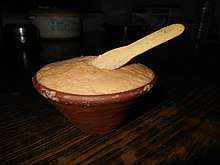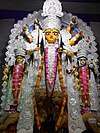Nabadwip-er lal doi
 popular red curd of Nabadwip | |
| Alternative names | Kheer doi, Chakku doi |
|---|---|
| Place of origin | India |
| Region or state | Nabadwip, West Bengal |
| Created by | Kalipad Modak, or some other Call him as Kali Ghosh |
| Serving temperature | Cold |
| Main ingredients | Milk |
| Variations | Misti doi |
Nabadwip-er lal doi (Bengali: নবদ্বীপের লাল দই English: Red curd of Nabadwip), also known as Kheer curd or Chakku doi, is one of the most famous types of confectionery in the Bengal region of the Indian subcontinent. Though curd is usually white, red curd is a distinct type of confectionery. Red curd of the Nadia’s Nabadwip type is very popular.[1] In the year of 1930, Kalipad Modak of Nabadwip, or some other Call him as Kali Ghosh was the first inventor of red curd.[2] One of the most famous red curd shop is "Laxmi Narayan Confectionery Store", that is 150-years old curd shop. After preparing the curd, it can be stored up to ten days.[3]
History
There is a legend behind red curd. It is known from Nabadwip's archaeological council that the birthplace of red curd is Nabadwips Phasitala, and the inventor is Kali Ghosh. Kali Ghosh and Hari Ghosh were two brothers, they used to make mostly curd and whey. They used to boiling buffalo milk in a gentle fire pouring a small amount of water to make it as condensed milk for a long time. The milk was turned reddish due to long burning. The two brothers used to make wheys from the milk. Their whey making area was known as Red Ghol or Red Whey. When milk becomes thick, it reaches to Kheer stage, so sometimes it is called Kheer yogurt.
Another name for this curd is Chakku yogurt. There is also a reason behind the name. The quality of the curd is judged on its stickiness. To test it, it is also seen by turning down the pot. Even a Chakku or a knife is inserted inside the pot. Thus the name of Chakku yogurt came from that knife.[4]
Preparation
This Curd or Yogurt is prepared in two steps, one step is to boil the milk, that is known as foot, and the next step is making it as curd. To prepare the yogurt, pure milk of cow or buffalo is required. There is also a huge contribution of fuel to prepare the red curd. Two types of fuel is needed for preparing the curd.[5] It takes two to six hours to take the first 'foot' of the boiling and it is made by burning wood. The 'foot' will continue until the red color is taken. Nearly three liters of milk is turned into one liter. The next stage of this step is burning in coal. In the case of white yogurt, milk is thickened, at that time, it is needed more time to prepare red curd, i.e. the milk density is thickest for red curd. When the milk is prepared, it is poured in the pots according to the size of the condensed milk, then it is placed around the coal fuel. Then the curd is covered with socks. This step is called yogurt making. And it forms the yogurt. Various types of pot size is supplied according to market demand. The curd contains from 100 grams of clay pots (glass) to five kilograms of yogurt pots. It is the best skill of the makers of Nabadwip that they make this red curd without any outer color.[2]
See also
References
- ↑ "বিজয়ার সন্দেশেই প্রতিবাদ জিএসটি-র". The Daily Anandabazar (in Bengali). OBP Group. 3 October 2017. Retrieved 22 November 2017.
- 1 2 বন্দ্যোপাধ্যায়, দেবাশিস (18 November 2017). "কেউ লাল কেউ দুধ-সাদা, দই দিয়ে যায় চেনা". The Daily Anandabazar (in Bengali). OBP Group. Retrieved 22 November 2017.
- ↑ "Chef Suman Chakraborty sets out on a trip across Bengal in search of its hidden gems — Mishti!". The Telegraph. OBP Group. 22 November 2017. Retrieved 22 November 2017.
- ↑ "হাঁড়ি উপুড় করলেও কিন্তু পড়বে না একফোঁটা দই". The Daily Anandabazar (in Bengali). OBP Group. 16 April 2013. Retrieved 22 November 2017.
- ↑ কুণ্ডু, অশোককুমার (28 April 2012). "লাল দইয়ের খ্যাতির সঙ্গে জড়িয়ে গিয়েছেন মনোরঞ্জন". The Daily Anandabazar (in Bengali). OBP Group. Retrieved 22 November 2017.
_-_1.jpg)
_-_4.jpg)
_-_6.jpg)
_-_7.jpg)
